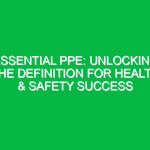Introduction
Personal Protective Equipment (PPE) must be approved for Health, Safety, and Environment (HSE) practices to ensure the Safety and well-being of workers across various industries. In an era where workplace Hazards are increasingly prevalent, understanding the significance of approved PPE is crucial. The consequences of neglecting proper Safety equipment can be dire, ranging from injuries to legal repercussions for companies. This article delves into the essentiality of PPE approval, exploring its relevance within the HSE domain, the Regulations governing it, and the Best Practices for implementation.
The Importance of Approved PPE in HSE
When we talk about PPE, we refer to equipment designed to protect workers from specific Hazards. This can include anything from helmets and gloves to respirators and Safety Goggles. However, not all PPE is created equal. The approval of PPE is crucial because it ensures that the equipment meets specific safety Standards and can effectively protect the user from identified risks.
For example, consider a construction site where workers are exposed to falling debris. A hard hat that meets the approved safety standards can significantly reduce the risk of head injuries. If the hard hat is not approved, it may not withstand the impact of falling objects, leading to severe injuries or fatalities. Thus, the phrase “PPE must be approved by” takes on grave importance in the context of HSE, as it underpins the very foundation of Workplace Safety.
Key Aspects of PPE Approval
Understanding Regulatory Frameworks
The landscape of PPE approval is governed by various regulatory frameworks, which vary by region and industry. In the United States, for instance, the Occupational Safety and Health Administration (OSHA) sets standards for various Types of PPE, while the American National Standards Institute (ANSI) provides guidelines on performance and testing. In Europe, the Personal Protective Equipment (PPE) Regulation (EU) 2016/425 outlines the essential health and safety requirements for PPE.
Compliance with these regulations not only enhances worker safety but also protects employers from potential lawsuits or penalties. For companies operating in multiple regions, understanding the specific requirements of each jurisdiction is vital.
Types of PPE and Their Approvals
The types of PPE vary widely, each serving a specific purpose. Here are some common categories along with their approval standards:
- Head Protection: Hard hats must meet ANSI Z89.1 standards in the U.S. to ensure they can withstand impact and penetration.
- Eye and Face Protection: Safety glasses and goggles should comply with ANSI Z87.1 to protect against flying debris.
- Respiratory Protection: Respirators must be approved by the National Institute for Occupational Safety and Health (NIOSH) to ensure they filter harmful substances effectively.
- Hearing Protection: Earplugs and earmuffs should meet the standards set by ANSI S3.19 to protect against noise-induced hearing loss.
- Body Protection: High-visibility clothing must comply with ANSI/ISEA 107 standards to ensure workers are seen in hazardous environments.
Understanding these categories and their respective standards is essential for any organization committed to HSE principles.
Best Practices for Selecting Approved PPE
Selecting the right PPE involves more than just choosing the first item that meets approval standards. Here are some Best Practices to consider:
- Conduct a Hazard Assessment: Identify potential hazards in the workplace and determine the appropriate PPE needed to mitigate those risks.
- Involve Employees: Workers wearing the equipment should have a say in the selection process, as they can provide valuable insights into comfort and usability.
- Regular Training: Provide ongoing training to ensure workers understand how to use the PPE correctly and recognize when it is necessary.
- Maintenance and Inspection: Implement a routine Maintenance schedule to inspect PPE for wear and tear and replace it as needed.
By adhering to these best practices, organizations can ensure that the PPE they provide not only meets approval standards but also serves its intended purpose effectively.
Potential Hazards and Risks
Not all hazards are visible, and sometimes, the risks associated with not using approved PPE can be subtle yet severe. For instance, exposure to chemicals may not result in immediate injury but can lead to long-term health issues such as respiratory diseases or skin conditions. Similarly, inadequate hearing protection may not seem like a pressing concern until the cumulative Effects of noise exposure manifest as permanent hearing loss.
Consider the case of a manufacturing plant where workers were exposed to high levels of noise without proper ear protection. Over time, several employees developed hearing loss, leading to costly compensation claims and a decline in worker morale. This example illustrates the importance of not only providing approved PPE but also ensuring that it is used consistently and correctly.
Regulations and Standards Governing PPE Approval
As highlighted earlier, regulatory bodies play a crucial role in the approval of PPE. These standards are not merely bureaucratic red tape; they are essential for safeguarding the health and safety of workers. Here are some key regulations that govern PPE:
- osha Standards: OSHA provides guidelines on the required PPE for various industries and ensures that employers provide appropriate equipment.
- ANSI Standards: ANSI sets forth performance standards for different types of PPE to ensure they can withstand specific hazards.
- NIOSH Approval: NIOSH certifies respiratory protection equipment, ensuring it meets stringent testing and performance criteria.
- EU PPE Regulation: In Europe, the PPE Regulation mandates that all PPE sold in the EU must meet specific health and safety requirements.
Understanding these regulations is vital for compliance and for fostering a culture of safety within the organization.
Conclusion
The phrase “PPE must be approved by” encapsulates a fundamental principle of Workplace Safety. In an environment where hazards abound, ensuring that the equipment used to protect workers is up to standard is non-negotiable. Approved PPE not only safeguards employees but also reinforces a company’s commitment to health, safety, and environmental Sustainability.
In summary, organizations must prioritize the selection and maintenance of approved PPE, conduct regular training, and remain vigilant about regulatory changes. As workplaces evolve and new hazards emerge, staying informed and proactive about PPE will not only protect your workforce but also enhance productivity and morale.
Ensuring that PPE is approved is not just a regulatory requirement; it is a vital step in fostering a safe work environment. By taking these measures, employers can fulfill their moral and legal obligations to protect their workers, paving the way for a healthier, safer future.


